Gas Laws
The Laws Governing Ideal Gases
- Ideal gas laws establish empirical connections between pressure (P), volume (V), and temperature (T) of an ideal gas.
- The gas’s mass and number of molecules remain constant in all of these relations.
Boyle’s Law
Boyle’s Law is expressed as: If the temperature T of an ideal gas is kept constant, then:

- The pressure of a gas is inversely proportional to its volume.
- The correlation between the pressure and volume of a fixed mass of gas at a constant temperature can also be stated as:
P1V1 = P2V2
- Where:
- P1 signifies the initial pressure (in Pa)
- P2 represents the final pressure (in Pa)
- V1 denotes the initial volume (in m3)
V2 indicates the final volume (in m3)
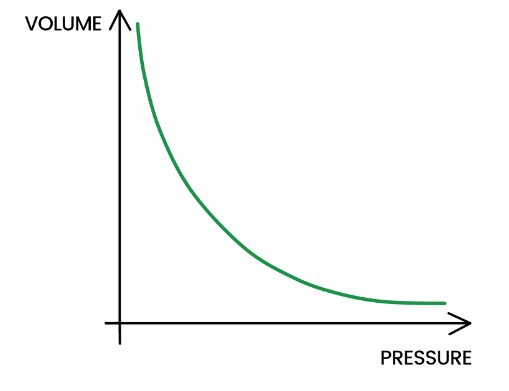
- With a change in temperature, the graph will shift away from or closer to the origin. Specifically, if the temperature increases, the graph will move further away from the origin, and vice versa.
The Principle of Charles’s Law:
- Charles’s Law is given by the formula, when the pressure P of an ideal gas is kept constant:
V ∝ T
- This relation shows that the volume of a gas is directly proportional to its temperature.
- The correlation between the volume and thermodynamic temperature of a fixed mass of gas at a constant pressure can also be expressed as:

- Where:
- V1 represents the initial volume (in m3)
- V2 indicates the final volume (in m3)
- T1 denotes the initial temperature (in K)
- T2 signifies the final temperature (in K)
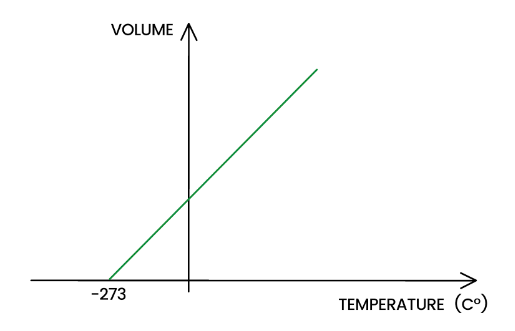
- In contrast, the graph showing temperature in Kelvin against volume will be identical, except that it will also be a straight line passing through the origin
The Law of Pressure:
- The Pressure law is represented by the formula when the volume V of an ideal gas is held constant.:
P ∝ T
- This equation indicates that the pressure of a gas is directly proportional to its temperature.
- The correlation between the pressure and thermodynamic temperature of a fixed mass of gas at a constant volume can also be expressed as:

- Where:
- P1 indicates the initial pressure (in Pa)
- P2 represents the final pressure (in Pa)
- T1 denotes the initial temperature (in K)
- T2 signifies the final temperature (in K)
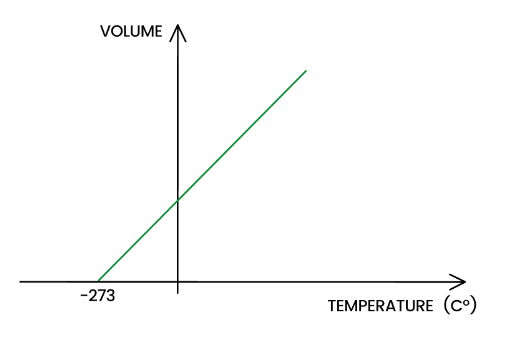
The Connections Among Pressure, Volume, and Temperature:
- An ideal gas is a gas that conforms to the relationship:
pV ∝ T
- Where:
- p represents the pressure of the gas (in Pa)
- V denotes the volume of the gas (in m3)
- T indicates the thermodynamic temperature (in K)
- The molecules in a gas move around randomly at high velocities, hitting surfaces and exerting pressure on them.
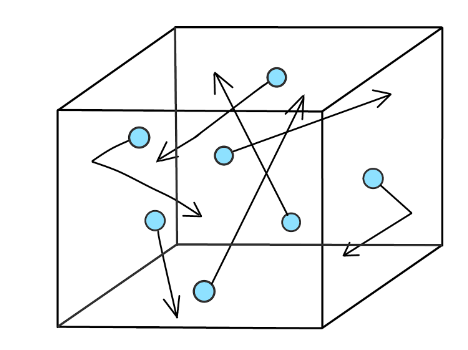
- Consider a box with gas molecules that are free to move around.
- The temperature of a gas is linked to the average velocity of the molecules:
- If the gas is hotter, the molecules move faster.
- Therefore, the molecules collide with the walls of the box more often.
- Since force is the rate of change of momentum:
- Every collision applies a force over the surface area of the walls.
- The faster the molecules strike the walls, the greater the force on them.
- As pressure is the force per unit area:
- Higher temperature leads to greater pressure.
- If the volume V of the box decreases, while the temperature T remains constant:
- There will be less surface area of the walls, resulting in more collisions
- This also creates more pressure
Therefore, the frequency of collisions of the gas molecules per unit area of a container determines the pressure in an ideal gas.
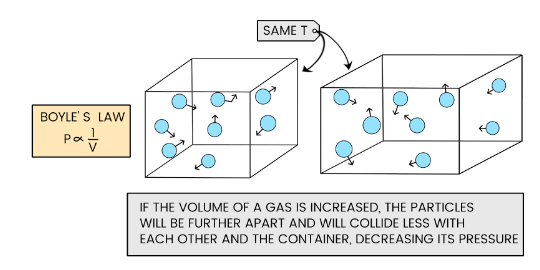
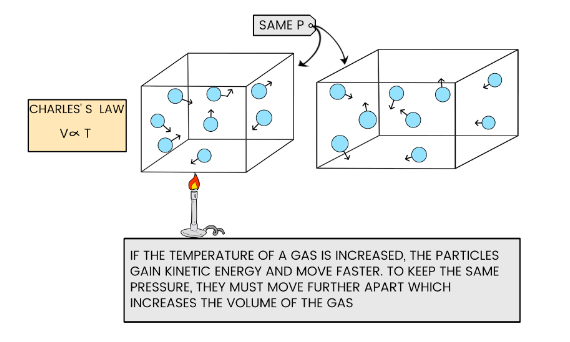
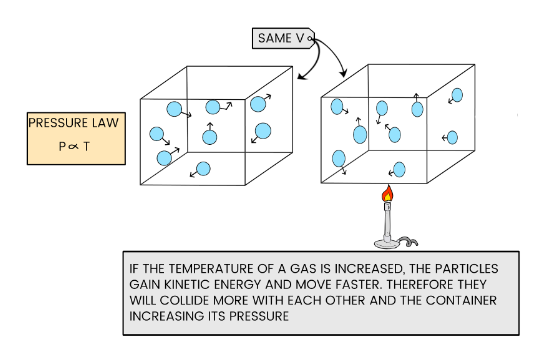
Ideal Gas Equation
- An ideal gas is characterized by the following attributes:
- Its molecules have an insignificant volume
- Collisions among its molecules are elastic
- It cannot be condensed into a liquid state
- Its molecules have no interactions with each other except during collisions
- It conforms to the ideal gas laws, namely Boyle’s law, Charles’ law, and the pressure law
- All of these events can take place
- The equation of state for an ideal gas, also known as the ideal gas equation, can be represented as:
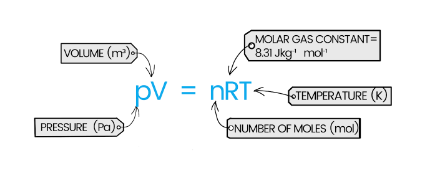
- It is also possible to express the ideal gas equation in the following format:
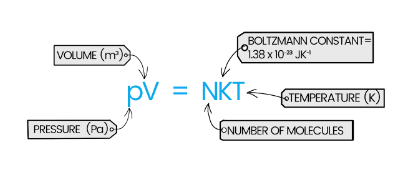
- An ideal gas is defined as:
a gas that adheres to the equation of state pV = nRT regardless of its pressure, volume, and temperature
Gas laws are a set of fundamental principles that describe the behavior of gases under different conditions such as pressure, temperature, and volume.
The four gas laws covered in A-Level Physics are Boyle’s Law, Charles’ Law, Gay-Lussac’s Law, and Avogadro’s Law.
Boyle’s Law states that the volume of a gas is inversely proportional to its pressure when temperature is kept constant. Mathematically, PV = k, where P is pressure, V is volume, and k is a constant.
Charles’ Law states that the volume of a gas is directly proportional to its absolute temperature when pressure is kept constant. Mathematically, V/T = k, where V is volume, T is temperature, and k is a constant.
Gay-Lussac’s Law states that the pressure of a gas is directly proportional to its absolute temperature when volume is kept constant. Mathematically, P/T = k, where P is pressure, T is temperature, and k is a constant.
Avogadro’s Law states that the volume of a gas is directly proportional to the number of moles of gas when pressure and temperature are kept constant. Mathematically, V/n = k, where V is volume, n is the number of moles of gas, and k is a constant.
Gas laws are fundamental to understanding many real-world phenomena, such as the behavior of gases in weather systems, the operation of internal combustion engines, and the function of the respiratory system in humans.
Gas laws can be used to solve a wide range of problems in physics and engineering. To solve a gas law problem, you need to identify the relevant law, the variables given, and the variable you need to solve for. You can then use the appropriate equation and algebraic manipulation to solve for the unknown variable.
Some common mistakes students make when working with gas laws include using the wrong units for pressure or temperature, failing to convert between units, forgetting to take into account the units of gas constant, and making algebraic errors in manipulating equations.
To avoid common mistakes when working with gas laws, it’s important to carefully read the problem statement and make sure you understand the units and variables involved. It’s also helpful to double-check your calculations and units at each step of the problem-solving process.





Still got a question? Leave a comment
Leave a comment